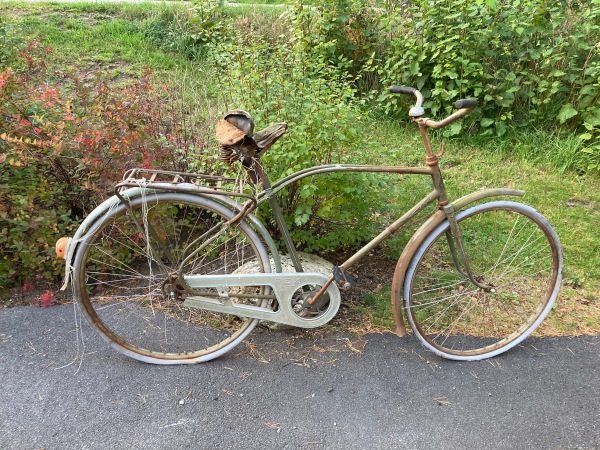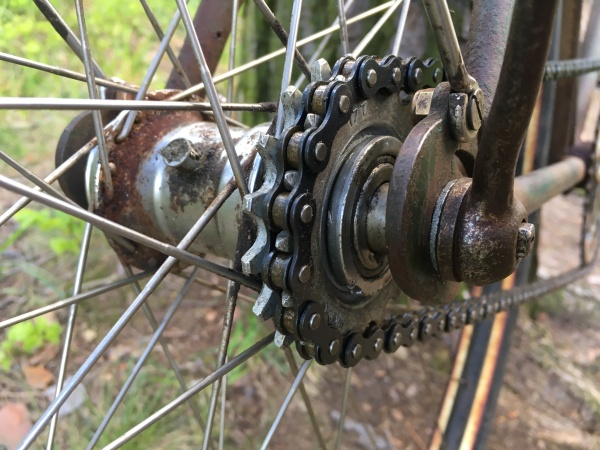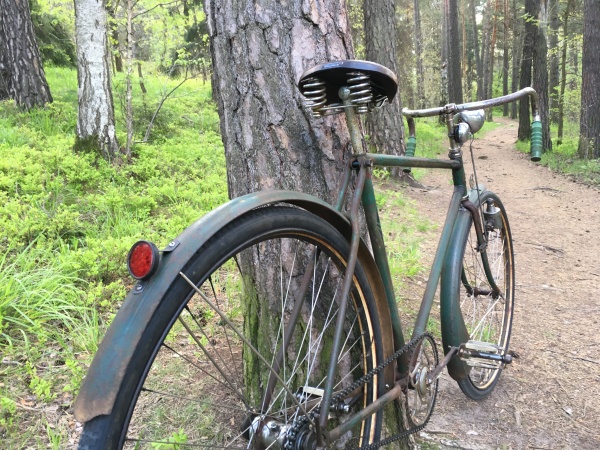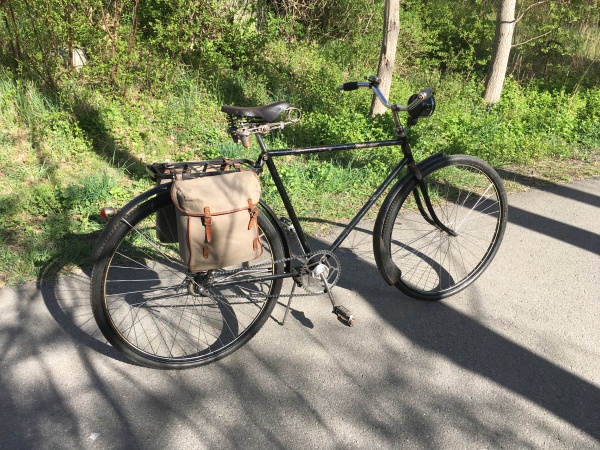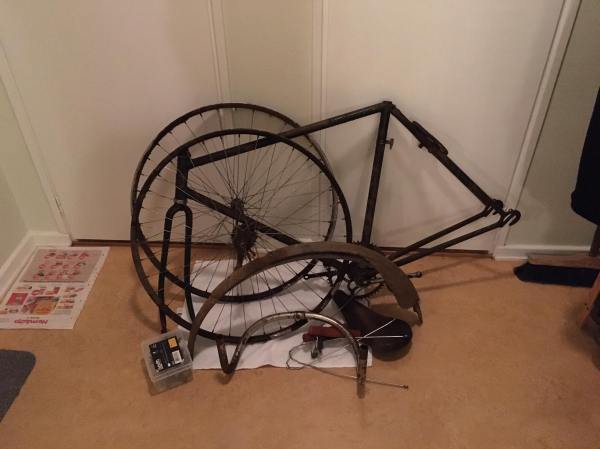In the end of February, the first ray of sunshine reminded us that the spring, perhaps a bit hesitant at first, but most certain are coming. In this situation I did what any tweedian would do. I brought out the old tweed jacket from its winter hibernation in the closet, packed a small picnic basket with tea and sandwiches. I tied a woollen scarf around my neck and off I went on the rusty old Rex Duplex bicycle.
Out and about in the sunshine. While cruising around stumbling pedestrians that behaved like newly awaken sloths, whilst slightly confused, admiring the bright light in the sky and having no idea where they were going. After a long dark and cold winter, spring is in the air.

Still some snow on the ground, but quickly melting away in the sunshine
After about a 5 kilometres ride I felt that it was time to have some refreshments. While I was sitting there at the old picnic table in the park, with a steaming hot cup of tea, eating my sandwiches and the birds chirping franticly in the hedges. I was reminded of an question I got a while back – why do I keep rambling on about tweed and writing in English?
The answer is actually really simple.

Picnic in the sun, chirping birds in the background as music
Some time ago I wrote a post (why Harris Tweed) about my interest in tweed, how tweed was in a way a part of my life. As a teenager I was handed down my fathers great looking Harris Tweed coat from the 1960’s. The coat was really something special, both in quality and in style. Most certain different than what all other teenagers wore at that time. But I liked it and wore it as often as I could.
Then in school we had a teacher who wore a grey herringbone Harris Tweed jacket to our classes. I notice now that I never used his name in my post, no idea why. That is strange since his name goes a bit along the tweed jacket. He described how he went to London once and the customs asked for his name. Here in Sweden we pronounce our names in Swedish, but when talking English, the name also receives an “English treatment”. He told the story on how he just said “Mr Eccmaan” and realized how silly it sounded when he just could have said it as usual Mr Ekman. We laughed and had good times in his classes, even back then I remember thinking that Mr Ekman’s jacket looked so distinguished and comfortable. So much so that I wanted one for myself.
A few years later I was handed down a old wool jacket from an old relative. It was a great jacket that I used until it dissolved into small pieces, truly well worn and loved. Many years I finally got around to buy myself a grey herringbone Harris Tweed jacket. It is the best jacket I had so far, sturdy, warm and reliable. Suits for any occasion from buying milk at the corner shop to attend tweed international events. Timeless, stylish and practical. Thank you Mr Ekman for the inspiration.

Grey herringbone Harris Tweed
Then we have the matter of my writing.
I have a good friend living just outside London. He was curious about what this “tweed-ride-bicycle-thingy” was that I was going on about all the time. He asked me to describe what we were doing at tweed events and what it means, in my opinion, to be a “tweedian”.
I tried to describ the general idea behind the events and what attracts me to join them. Dressed in tweed and riding rusty old bicycles, listening to jazz and all things in-between. What is the secret?
The first obstacle on my journey to be a amateur reporter and chronicler, was to simply write. My rather average knowledge in the English language quickly put my writing ambitions to a grinding halt. Since I had only studied English way back in elementary school as a kid, all knowledge of how to spell, using grammar and everything else became an real challenge for me.
Since the years in school I had been on vacation, ordering food and drinks in English, but never written longer text segments. My friend in London came with helpful insights on how to write along the way. He helped me, not only to simply write, he also gave me hints about the how to design the posts, how to add more text, more photos, how to use spaces, commas and so on. Not to only make the text readable, but more interesting by showing photos backing up the texts. After all – a photo says more than 1000 words.
Soon I started to write more elaborated about the tweed events, describing the events in more details, describing my bicycles with both text and photos so others could see the small details and read my story behind the events and bicycles. Trying to create a living story.
As the years went along. I got a better understanding of the process of writing, not to the fullest, far from it actually. Writing is as many other things in life, you will never get perfect in anything, only decent. But trying is half the victory. There is always room for improvement and I got many helpful and really great lessons along the way. I am very grateful for Mr Withers amazing patience and knowledge in writing.

Bicycles ready for summer and tweed events
To a more serious note. I read somewhere on a forum, that there were a person who did not want to participate in tweed events. Juts becasue the person had the impression of that all participants in events like that were longing back to a time when the sun never did set on the British empire. Where enslaved people and colonization was a normal practice, working classes were abused.
In my personal opinion after participating in over 32 tweed rides in 6 different countries. Looking at tweed events like that, is a matter of seeing things that simply are not there. In every society, club or social gathering you can find them there. People that do not understand, or even want to understand. I can safely say that politics, strange old ideas and horrible out dated visions are never discussed or practised on these events.
I would instead like to describe a general tweed event as an odd version of a P-G Woodhouse novel. We want to dress up, ride a fancy bicycle in a kind, loving world where it is always summer all year round. Posh people are a bit silly and daft, there is tea and cake near by. Whilst the most critical problem in the world would be, if there would be no ice to the gin and tonic drinks later on.
Tweed ride events are filled with people who like to, dress up, meet other tweedians, admire their clothes, their bicycles, their picnic setups and just have a good time and a hearty laugh. Far from the problems, routines and menace of everyday life.

Being a tweedian is a fun and therapeutic, almost, full time job. Mending, writing and planning all along with a cup of tea.
Now, put on a tweed jacket. Pack a picnic hamper, bring along an old beaten up enamel cup and take a ride on a vintage bicycle. Enjoy the simple and relaxing way to get around and having fresh air at the same time. Stop for a moment and have a cup of tea, while just enjoying the moment.
Join a Bike in Tweed event and have a great time with other tweedians. Why not take part in silly games like hat throwing or guessing how many ice cubes there is in a glass of gin and tonic. We all need to have fun today, tomorrow is far away.
Ride safely and happy tweed fellow tweedians!


